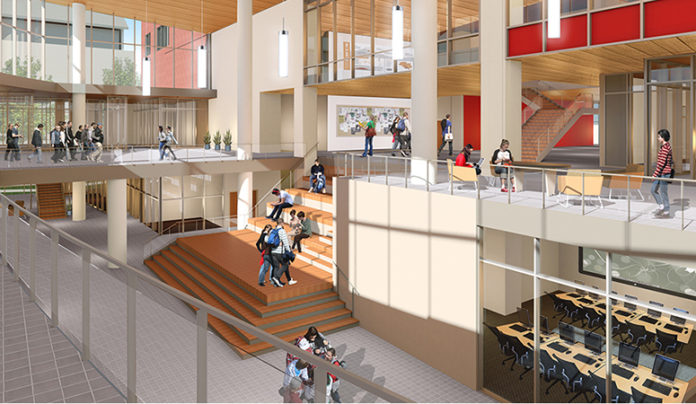
Editor’s note: This is the second story in a series to be presented throughout the next several months about the progress being made on UofL’s new classroom building.
At a glance mid-construction, the Belknap Academic Classroom Building very much looks the part it was meant to play – contemporary, state-of-the-art, spacious.
The nearly 170,000-square-foot building, on pace to open by the fall semester, is dedicated entirely to student success as evidenced through its active learning classrooms. The classrooms, for example, will include movable furniture, white boards for student use and interactive Mersive Solstice pods for wireless connection to classroom displays.
The building also has many informal meeting spaces for group work and projects outside of class time, a Student Success Center and labs for physics, biology, chemistry and anthropology.
Think: less lecture hall, more student/teacher engagement.
According to Gale Rhodes, executive director of the Delphi Center for Teaching and Learning, traditional, faculty-centered teaching methods are not always optimal for student learning.
“Innovation in higher education is essential and traditional. Research on learning and in brain science has demonstrated that interactive, student-centered teaching methods position students for greater success,” she said.
There is ample evidence to support this approach and that research stretches back throughout the past 30 years. Active learning research traces its roots to the Studio Course model at Rensselar Polytechnic Institute, which was incorporated into the curriculum in 1994. NC State Physics Professor Robert Beichner also pioneered the Scale-Up classroom in the mid-1990s, which focused on student interactivity, or “upside down pedagogies.”
One of the most cited studies is Scott Freeman’s 2014 paper that analyzed 263 active learning studies. Freeman and his colleagues found that students’ probability of failure was significantly less with active learning.
However, translation to practice has been slow, according to Rhodes, due in part to faculty’s and students’ notions of what effective teaching and learning is.
“In the past, there has been a lack of support for faculty to innovate. That’s what this building will do,” she said.
There are plenty of universities and colleges that have active learning classrooms, but very few have entire classroom buildings dedicated to active learning.
“We will be one of a small group of universities in the country to have a large classroom building entirely dedicated to active learning classrooms. The University of Minnesota built one of the first buildings in 2010, and only a handful have opened since,” Rhodes said, adding that experts predict ALCs will be mainstream by 2020.
In preparation for the fall 2018 opening of the BACB, UofL’s Teaching Innovation Learning Lab has been supporting and training faculty for this approach.
“(The TILL) provides an opportunity to experiment in a state-of-the-art learning space while having the benefit of technological and instruction support, and it is equipped with identical technology that will be found in the new building,” Rhodes said.
Learning spaces represent improved understanding of pedagogy
Jeff Hieb, assistant professor of Engineering Fundamentals in the Speed School, said he will spend time in the new building observing how other faculty are using these classrooms. Still, he doesn’t consider the BACB’s focus to be on new teaching methods as much as it is on new learning spaces.
“The reason we need a building with new types of learning spaces is that they represent our improved understanding of the role technology, space and pedagogy can play in student learning and student success,” Hieb said. “The spaces improve student interaction, allow faculty to have high quality interactions with small groups of students, and the technology is designed to promote collaboration, which is a skill students need to develop.”
In addition to improving interaction and collaboration, Rhodes said the building will also serve as an effective recruitment and retention tool for the University of Louisville.
“This state-of-the-art building will attract first- and second-year students and top faculty to UofL, retain them, and best meet their advising and support needs,” she said. “It represents the new future of teaching, allowing our university to meet educational needs in ways we never have before.”





























